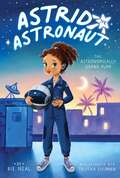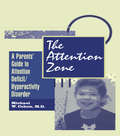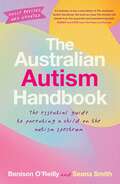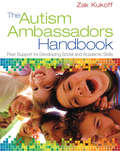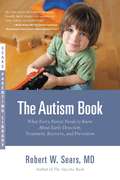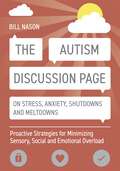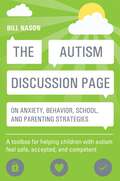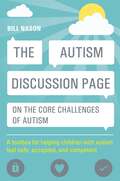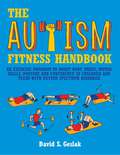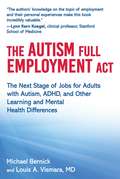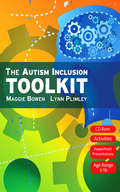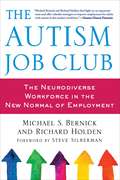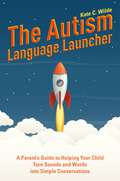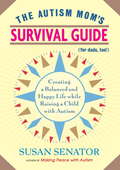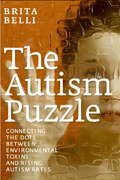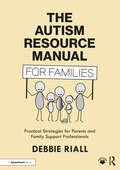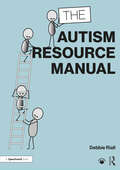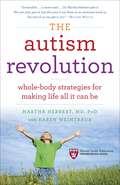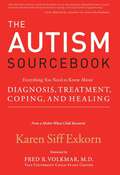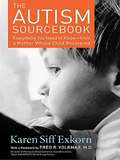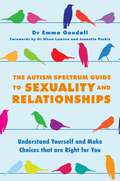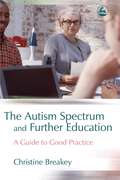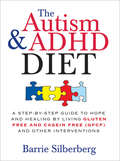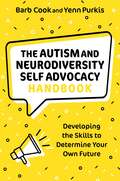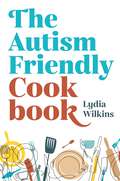- Table View
- List View
The Astronomically Grand Plan (Astrid the Astronaut #1)
by Rie NealIn this first book of a brand new-chapter book series, a young girl is determined to be the first astronaut with hearing aids in space!Astrid can&’t wait for the school year to start so she can put her Astronomically Grand Plan into action! She and her best friend, Hallie, are going to be in their first year of Shooting Stars, a club dedicated to all things space. Astrid&’s big sister has told her all about it, and this year, there is a big, wonderful prize: a trip to a real-life space camp! But Astrid&’s Grand Plan isn&’t off to a great start: it turns out Hallie is more interested in the art club, Petite Picassos! And Astrid isn&’t sure that her goal of exploring space will happen the same way without her BFF by her side. Can Astrid figure out a way to complete her mission?
The Attention Zone: A Parent's Guide To Attention Deficit/Hyperactivity
by Michael CohenFirst published in 1998. Routledge is an imprint of Taylor & Francis, an informa company.
The Australian Autism Handbook: The essential guide for parents of children with autism
by Seana Smith Benison O'ReillyA fully updated edition of the widely praised and most trusted Australian guide on how to raise a child with autism spectrum disorder.An essential, comprehensive and INCLUSIVE guide for parents and carers of kids with autism. Advice from leading world experts delivers the information you can TRUST.Offers SUPPORT AND GUIDANCE on early signs of ASD; diagnosis; medical theories; schooling and growing up; intervention programs; treatments; dealing with emotions (parents and child); what not to say to your child and how to help them.SHARES the lived experience of fellow parents who are raising kids with autism and we hear from adults who have autism to hear their perspective. So much has changed since 2008: the language of autism, diagnoses, the understanding of disability, society, culture and agency. This new edition sparkles with new ENERGY and new horizons.
The Autism Ambassadors Handbook: Peer Support for Learning, Growth, and Success
by Zak KukoffSometimes, all a student needs to succeed is a friend. Every day, thousands of students with autism spectrum disorders (ASD) struggle to stay afloat at school—sometimes bullied, often ostracized, these students could benefit from a peer who models and reinforces socially appropriate behavior and coaches them through challenging schoolwork. This inspirational new book describes how to set up just such a peer-mentoring organization in your school. Kukoff provides: Steps for organizing and implementing your own Autism Ambassadors program Clear-cut guidelines on what it entails for student “ambassadors” More than a hundred specific interventions any student can employ with students with ASD
The Autism Book: What Every Parent Needs to Know About Early Detection, Treatment, Recovery, and Prevention
by Robert SearsWith clarity and compassion, Dr. Robert Sears guides the reader through the maze of autism, explaining what precautions parents can take to decrease their baby's risk, how to detect autism at the earliest possible age, and how to proceed once a diagnosis has been made. The book provides parents with a simple and clear understanding of the biomedical treatment approach that Dr. Sears has used successfully with many of his young patients. It lays out a plan for developmental, behavioral, and learning therapies; shows parents how to begin treatments without a doctor's help; presents information on vaccines and their safe use; and includes an extensive resources section. THE AUTISM BOOK provides all the information and reassurance parents need.
The Autism Discussion Page on Stress, Anxiety, Shutdowns and Meltdowns: Proactive Strategies for Minimizing Sensory, Social and Emotional Overload
by Bill NasonAnxiety, meltdowns and emotional regulation can be hugely challenging for autistic people. This book is full of proactive strategies for understanding, accepting and respecting the processing differences in autism. It contains tools for reducing sensory, social and mental drain, and offers strategies to protect from ongoing stress and anxiety. These help minimize shutdowns and burnout, while maximizing self-esteem, autistic identity and mental health.Learn strategies for matching environmental demands to the person's processing needs, how to support vulnerabilities, and how to prevent and manage meltdowns while protecting the identify and self-esteem of the individual with autism.
The Autism Discussion Page on anxiety, behavior, school, and parenting strategies: A toolbox for helping children with autism feel safe, accepted, and competent
by Bill NasonThe Autism Discussion Page green book covers anxiety and stress, challenging behaviors, stretching comfort zones, discipline, and school issues. It also provides more general teaching and mentoring strategies for coaching children on the autism spectrum in basic daily living strategies to improve their day-to-day lives. Based on posts on the popular online community page and organised by subject for ease of reference, this book offers an excellent understanding of how children with autism process and experience the world and effective strategies for coping with the challenges.
The Autism Discussion Page on the core challenges of autism: A toolbox for helping children with autism feel safe, accepted, and competent
by Bill NasonThe Autism Discussion Page blue book focuses on the core challenges associated with autism (cognitive, sensory, social, and emotional) and provides concise, accessible information and simple tools for supporting children with these vulnerabilities. Based on posts on the popular online community page and organised by subject for ease of reference, this book offers an excellent understanding of how children with autism process and experience the world and effective strategies for coping with the challenges.
The Autism Fitness Handbook: An Exercise Program to Boost Body Image, Motor Skills, Posture and Confidence in Children and Teens with Autism Spectrum Disorder
by Stephen M. Shore David GeslakDesigned to address specific areas of difficulty for children, teens and young adults with autism spectrum disorder (ASD), the 46 exercises in this comprehensive program are proven to improve body image, motor coordination, posture, muscular and cardiovascular fitness. The boost to confidence, relationships and general wellbeing resulting from this will be transformative for individuals with ASD and their families. Used extensively in homes, schools and specialist ASD programs, the exercises require minimal equipment and can be used in a wide range of settings. Accompanied by clear instructions and explanatory cartoon illustrations, they are easy for non-specialists to follow and can be used just as effectively with groups or individuals. Packed with helpful advice from the author, an ASD fitness specialist, as well as inspiring case studies and guidelines on adapting the exercises for different ages and abilities, this popular program contains everything needed to get minds and bodies active while having fun!
The Autism Full Employment Act: The Next Stage of Jobs for Adults with Autism, ADHD, and Other Learning and Mental Health Differences
by Michael Bernick Louis A. VismaraImpactful and integral to our economic recovery after the pandemic, The Autism Full Employment Act will rebuild and approve autism employment programs. Employment remains the issue today for many adults with autism. During the pandemic of 2020, authors Michael Bernick and Dr. Lou Vismara, along with other adults with autism, practitioners, and advocates, set out to develop an Autism Full Employment Act. At the time, the national economy was decimated, and it was clear that it would need to be rebuilt, starting in 2021 and beyond. The Act is an attempt not only to rebuild autism employment programs, but also to address the limitations and shortcomings of the current system. The Autism Full Employment Act shows how there can be a place in the job world for the wide range of adults with autism, ADHD, and other learning and mental health differences—many of whom are not employed today. Bernick and Dr. Vismara review the autism employment initiatives in recent years among major employers, state and local governments, autism-focused businesses, and autism transition programs, and present strategies to build on these initiatives. They set out more fully the meanings of &“autism talent advantage,&” &“autism friendly workplace,&” and &“employment for the more severely impacted.&” Six broad strategy areas are explored. Interspersed with these six strategy areas are notes on related issues of &“professionalizing the direct support workforce,&” &“transitions,&” and &“comorbidities.&” Bernick and Dr. Vismara end by considering why no government action or program can replace the employment journey of each adult with autism, but how instead the Act can hasten these journeys.
The Autism Inclusion Toolkit: Training Materials and Facilitator Notes
by Ms Lynn Plimley Maggie Bowen'This resource will be very valuable for professionals planning in-service training to assist settings to develop as Autistic Spectrum Disorder-friendly environments...the training would also help all settings become truly inclusive and friendly for all children and young people' - Special Children Includes CD-Rom A growing number of pupils with Autistic Spectrum Disorders (ASDs) are educated in mainstream settings. To support them effectively and maximise their learning potential, it is essential that all school staff fully understand their needs. This complete training package can be delivered during staff meetings and on INSET days, to ensure autism-friendly practice throughout the school. This toolkit demonstrates the value of using self-evaluation tools to improve services and includes: - a CD Rom with PowerPoint slides - guidance on how best to deliver INSET - activities and case studies to facilitate discussion - discussions of issues for consideration in relation to School Access Plans and the Disability Equality Duty - advice on useful resources, literature and web sites. Teachers, SENCOs and management staff in primary and secondary schools will find this an essential training resource.
The Autism Job Club: The Neurodiverse Workforce in the New Normal of Employment
by Steve Silberman Richard Holden Michael BernickThe Autism Job Club is a groundbreaking book for bringing adults with autism and other neuro-diverse conditions into the work world. This second edition of The Autism Job Club includes a new Foreword by Steve Silberman, author of the best-selling NeuroTribes, along with an Afterword by the authors. The Afterword covers the many employment initiatives for adults on the autism spectrum launched just in the three years since the book was originally published. The book has its basis in the autism job club that the authors have been part of in the San Francisco Bay Area, the job-creation and job-placement efforts the club has undertaken, and similar efforts throughout the United States. The authors review the high unemployment rates among adults with autism and other neuro- diverse conditions more than two decades after the ADA. Bernick and Holden also outline and explain six strategies that, taken together, will reshape employment for adults with autism: the art of the autism job coach; the autism advantage in technology employment; autism employment and the internet economy; autism employment and the practical/craft economy; autism and extra-governmental job networks; autism and public service employment.The Autism Job Club is a vital resource for adults with autism, their families, and advocates who are committed to neuro-diverse employment, not unemployment. But it also speaks to a far broader audience interested in how to carve out a place for themselves or others in an increasingly competitive job world.
The Autism Language Launcher: A Parent's Guide to Helping Your Child Turn Sounds and Words into Simple Conversations
by Kate WildeDo you want to help your child on the autism spectrum to verbally communicate with you and others?You've picked up the right book.The Autism Language Launcher gives you something totally new: a step-by-step guide that ignites language lift-off by using methods such as tapping into your child's innate intelligence, going with your child instead of against your child and providing techniques that work with adults on the spectrum.Written for parents, relatives, professionals, educators, or caregivers of a child or adult who is not yet verbal, making some sounds, using some words, speaking in single words, or using two-word phrases, this book uses the author's decades of experience with children and adults on the spectrum.Kate also demonstrates how to effectively address your child's echolalia, repetitious language, and repetitive questions in a way that your child will find supportive, bonding, and even joyful. Ultimately, this book shows you how to make language happen.
The Autism Mom's Survival Guide (for Dads, too!): Creating a Balanced and Happy Life While Raising a Child with Autism
by Susan SenatorGiven the daily challenges of raising a child with autism, it's easy for parents to lose themselves and for their overall quality of life to plummet. Susan Senator interweaves the voices of autism parents, researchers, and professionals to offer guidance and encouragement on how to find happiness and fulfillment in the midst of the struggles of raising an autistic child. Topics include: how to handle feelings of despair and hopelessness; finding fun, even during turbulent times; caring for your marriage; and finding a balance between accepting your child as he or she is and seeking new treatments. To learn more about the author, visit her website at susansenator.com.
The Autism Puzzle
by Brita BelliThe alarming spike in autism in recent years has sent doctors and parents on a search for answers. And while many controversies have erupted around the issue, none have gotten us any closer to a definitive explanation, and many key concerns remain unexplored. Moving beyond the distractions of the vaccine debate, The Autism Puzzle is the first book to address the compelling evidence that it is the pairing of environmental exposures with genetic susceptibilities that may be impacting the brain development of children. Journalist Brita Belli brings us into the lives of three families with autistic children, each with different ideas about autism, as she explores the possible causes. She interprets for readers compelling evidence that environmental toxins--including common exposures from chemicals mounting in our everyday lives--may be sparking this disorder in vulnerable children. Belli calls for an end to the use of hazardous materials--like toxic flame retardants used in electronics and furniture, which have been banned elsewhere--insisting that we cannot afford to experiment with our children. The Autism Puzzle puts a human face on the families caught in between the debates, and offers a refreshingly balanced perspective.
The Autism Resource Manual for Families: Practical Strategies for Parents and Family Support Professionals
by Debbie RiallThe Autism Resource Manual for Families is a treasure trove of practical, realistic and achievable strategies to support neurodivergent young people and their families with everyday life. Clearly laid out for easy use and access, it explains autism in context and provides ideas that are relevant not just for parents and carers, but for family support workers, social workers and family intervention teams. The resource covers a wide range of situations and offers an array of supports, with key topics ranging from anxiety, behaviour, and communication, to socialising, family life, and moving towards independence. With the lived experiences of parents and autistic children and young people in mind, this empowering manual includes: A wealth of situations from daily life, clearly addressed with examples of how autistic individuals may experience these and practical strategies for effective support Encouragement for parents and mini mantras for autistic children and young people to use in different situations Strategies for supporting autistic children in daily family life, including working with siblings, family holidays and eating out Advice for helping autistic young people through school, including attendance, homework and after-school exhaustion Guidance on initiating and carrying out productive conversations, as well as downloadable resources for visual conversation support. This book will be an essential tool for parents and carers of neurodivergent children and young people, as well as family or parent support workers and family intervention teams. It will also be valuable reading for pastoral teams, CAMHS, and social workers supporting these families.
The Autism Resource Manual: Practical Strategies for Teachers and other Education Professionals
by Debbie RiallThis highly practical resource book is full of realistic and achievable strategies to help teachers to support neurodiverse students in a range of situations that, whilst often seemingly insignificant, can quickly become substantial and disruptive challenges in the mainstream classroom. Written with the busy teacher in mind, chapters are easy to dip in and out of, with jargon-free language and simple explanations which are easy to understand and put into practice. Clear chapters explore a variety of situations and topics to help children engage in their learning and make the classroom a safe and inviting place to be for autistic students. Key features include: Practical and achievable strategies to support autistic students in the mainstream classroom Real-life scenarios to help you find concrete solutions to issues as they arise Memorable mantras and quick quotes to help embed strategies in everyday practice for both students and teachers Photocopiable and downloadable resource sheets Written by an advisory teacher for autism with a wealth of experience, this book will be an invaluable tool for both primary and secondary teachers in mainstream settings, as well as other education professionals.
The Autism Revolution: Whole-body Strategies for Making Life All It Can Be
by Karen Weintraub Martha HerbertMove beyond conventional thinking about autism. . . . After years of treating patients and analyzing scientific data, prominent Harvard researcher and clinician Dr. Martha Herbert offers a revolutionary new view of autism and a transformative strategy for dealing with it. Autism is not a hardwired impairment programmed into a child's genes and destined to remain fixed forever, as we're often told. Instead, it is the result of a cascade of events, many seemingly minor: perhaps a genetic mutation, some toxic exposures, a stressful birth, a vitamin deficiency, and a series of infections. And while other doctors may dismiss your child's physical symptoms--the diarrhea, anxiety, sensory overload, sleeplessness, immune challenges, and seizures--as coincidental or irrelevant, Dr. Herbert sees them as vital clues to what the underlying problems are, and how to help. In The Autism Revolution, she teaches you how to approach autism as a collection of problems that can be overcome--and talents that can be developed. Each success you achieve gives your child more room to become healthy and to thrive. Drawing from the newest research, technologies, and insights, as well as inspiring case studies of both children and adults, Dr. Herbert guides you toward restoring health and resiliency in your loved one with autism. Her specific recommendations aim to provide optimal nutrition, reduce toxic exposures, shore up the immune system, reduce stress, and open the door to learning and creativity--all by understanding and truly meeting your child's needs. As thousands of families who have cobbled together these solutions themselves already know, this program can have dramatic benefits--for your child with autism, and for you, your whole family, and your next baby as well. A paradigm-changing book that offers hope and healing for the millions of families who have autism in their lives, The Autism Revolution shows that there's plenty you can do every day to give someone you love the best possible gift: a life lived to the fullest potential.From the Hardcover edition.
The Autism Sourcebook: Everything You Need to Know About Diagnosis, Treatment, Coping, and Healing
by Karen Siff ExkornPractical advice and information from the world's foremost experts on autism -- and a mother's own hard-won lessons from helping her son recover from the disorderWhen Karen Siff Exkorn's son, Jake, was diagnosed with autism, she struggled to pull together comprehensive information about the disorder. Fortunately, she was able to educate herself quickly, and her extensive at-home treatment of her son led to his amazing full recovery. But the journey wasn't easy, and now, in The Autism Sourcebook, Siff Exkorn offers parents the wisdom she wishes she'd had at the beginning.Recent studies show that there is a worldwide epidemic of autism. More than 1.5 million people are affected in the United States alone, with one in every 166 children diagnosed. Early detection and early intervention are two of the key factors in improving prognosis -- but too often, writes Siff Exkorn, parents get bogged down in denial or confusion about the still mysterious disorder, and are unable to take the necessary steps. Providing accessible medical information gleaned from the world's foremost experts, Siff Exkorn offers an inside look at families with children who have autism, and ties in her own firsthand experience as a parent. The author shares valuable knowledge about the following:What the diagnosis really meansUnderstanding and accessing treatment optionsKnowing your child's rights in the school systemCoping with common marital and familial stressMaking the stigma of autism a thing of the pastWith extensive appendices, including the Modified Checklist for Autism in Toddlers, Diagnostic Criteria for the Five Pervasive Developmental Disorders, and carefully selected lists of Internet resources, recommended readings, and top autism organizations worldwide, The Autism Sourcebook is the single most comprehensive, practical resource available to parents and loved ones of children with autism.
The Autism Sourcebook: Everything You Need to Know about Diagnosis, Treatment, Coping, and Healing--From a Mother Whose Child Recovered
by Karen Siff ExkornPractical advice and information from the world's foremost experts on autism -- and a mother's own hard-won lessons from helping her son recover from the disorder. When Karen Siff Exkorn's son, Jake, was diagnosed with autism, she struggled to pull together comprehensive information about the disorder. Fortunately, she was able to educate herself quickly, and her extensive at-home treatment of her son led to his amazing full recovery. But the journey wasn't easy, and now, in The Autism Sourcebook, Siff Exkorn offers parents the wisdom she wishes she'd had at the beginning. Providing accessible medical information gleaned from the world's foremost experts, Siff Exkorn offers an inside look at families with children who have autism, and ties in her own firsthand experience as a parent. The author shares valuable knowledge about the following: *What the diagnosis really means * Understanding and accessing treatment options * Knowing your child's rights in the school system * Coping with common marital and familial stress * Making the stigma of autism a thing of the past With extensive appendices, including the Modified Checklist for Autism in Toddlers, Diagnostic Criteria for the Five Pervasive Developmental Disorders, and carefully selected lists of Internet resources, recommended readings, and top autism organizations worldwide, The Autism Sourcebook is the single most comprehensive, practical resource available to parents and loved ones of children with autism.
The Autism Spectrum Guide to Sexuality and Relationships: Understand Yourself and Make Choices that are Right for You
by Jeanette Purkis Wenn B. Lawson Emma GoodallUnravelling the complexities of relationships and sexuality, this straight-talking guide will help you to navigate the associated social, emotional and physical issues. Expert advice and real life examples give you the knowledge to reflect on your own sexuality, provide you with information on different types of relationship, and gives you the confidence to decide which type of relationship is right for you. Together with important information on sexual health, this book will help you to understand how to find and maintain a relationship of your choosing in a safe and enjoyable way. Exploring the often unspoken rules of sex and relationships, this book also covers often unaddressed topics, such as: · what sexual attraction looks and feels like · how to identify your own sexual identity and preferences (and how they may change) · what your rights are, and how to stay safe · having children, or choosing not to, the impact of this on relationships · how to recognise power imbalances within relationships, and what to do
The Autism Spectrum and Further Education: A Guide to Good Practice
by Christine BreakeyThis guide for professionals working with students with autism spectrum conditions (ASCs) in further education meets the increasing demand for information and support on this subject. Christine Breakey provides useful guidelines and practical advice on teaching young adults successfully and confidently, emphasising the development of resources and practical skills for use specifically in FE colleges. The author covers all the key areas and offers strategies and solutions for communicating effectively, helping students to manage transition, and understanding and minimising the causes of ASC behaviours as well as teaching social skills and ASC self-awareness. The Autism Spectrum and Further Education will be a vital resource for professionals in FE institutions who have to meet the needs of young adults with ASCs.
The Autism and ADHD Diet
by Barrie SilberbergThis is what parents are saying about an amazing diet that is showing extraordinary results in helping children eliminate many traits and symptoms associated with autism spectrum disorders, ADHD, celiac disease, and other conditions. The Gluten-Free, Casein-Free (GFCF) Diet, as well as removing all artificial dyes and preservatives, is hugely effective for thousands of families. The Autism & ADHD Diet is your complete guide to the GFCF Diet. Barrie Silberberg, a mother who honed her skills using the GFCF Diet with her son, who was diagnosed with ASD, gives you everything you need to know to put the diet into action with your child, including: * What the GFCF Diet is and why it's so effective * How to start the diet * Where and how to buy GFCF foods * How to avoid cross-contamination * How to understand labels on packaging * How to make this diet work day-to-day Packed with parent-proven tips and the best resources for the diet, The Autism & ADHD Diet will alleviate all of your questions and provide a variety of ways to make this diet work best for you and your family.
The Autism and Neurodiversity Self Advocacy Handbook: Developing the Skills to Determine Your Own Future
by Barb Cook Yenn PurkisBeing autistic, you might come across more challenges than others around you, such as dealing with ableism, discrimination in employment or difficulties in your relationships. Learning to successfully self-advocate will help you to build confidence, strengthen your relationships and ensure your needs are met.Written by two autistic activists, this book will give you the tools and strategies to advocate for yourself in any situation. It covers specific scenarios including work, school, and family and relationships, as well as looking at advocacy for the wider community, whether that's through social media, presentations or writing. Additionally, the book provides advice on building independence, developing your skills, standing up for others and resolving conflict.The authors also explore the overall impact of self-advocacy in all areas of your life, building a sense of confidence, resilience and control. Drawing on the authors' extensive experience, this book will help you to successfully prioritise your needs and rights, challenge what is unfair or unjust and make your voice heard.
The Autism-Friendly Cookbook
by Lydia WilkinsThe Autism-Friendly Cookbook was created by journalist Lydia Wilkins for autistic adults and teens to turn to when cooking for friends, lacking inspiration, or on those low-energy days. With recipes to suit any occasion, the book is written in clear, jargon-free language which makes 'the obvious' obvious.Recipes are categorised by meal with additional guidance on the level of energy needed to tackle them, with options for low-energy or meltdown days, or days when you're able to take on a new challenge. They contain adaptations and options to suit different dietary needs including vegetarian, vegan, gluten-free and dairy-free, and additional modifications for those who are sensory seekers, sensory avoiders or who want to expand their repertoire in the kitchen.With contributions from individuals within the autistic community and options for quick meals, special occasions and more. With autistic people at its heart, the book also contains helpful tips and advice for parents and teachers looking to find out more.
